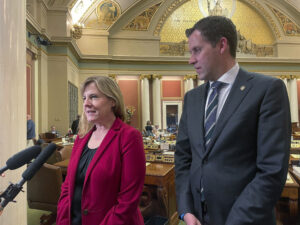Return of the Great Triangulator
The sight of Bill Clinton back at the White House podium defending tax cuts for the super-rich was more a sick joke than a serious amplification of economic policy.
The sight of Bill Clinton back on the White House podium defending tax cuts for the super-rich was more a sick joke than a serious amplification of economic policy. How desperate is the current president that he would turn to the great triangulator, who opened the floodgates to banking greed, for validation of the sorry opportunistic hodgepodge that passes for this administration’s economic policy? A policy designed and implemented by the same Clinton-era holdovers whose radical deregulation of the financial industry created this mess in the first place.
As a candidate running against Hillary Clinton, Barack Obama quite accurately excoriated the economic policies of the Clinton years when the Democratic president united with congressional Republicans, led by Senate Banking Committee Chairman Phil Gramm, to obliterate sensible regulations of the New Deal. The result, as candidate Obama noted in March 2008, has been chaos:
“Unfortunately, instead of establishing a 21st century regulatory framework, we simply dismantled the old one—aided by a legal but corrupt bargain in which campaign money all too often shaped policy and watered down oversight. In doing so, we encouraged a winner-take-all, anything-goes environment that helped foster devastating dislocations in our economy.”
These dislocations were authorized when Clinton signed off on the Gramm-Leach-Bliley Act, which reversed the Glass-Steagall Act’s separation between the high rollers of investment banking and the properly conservative, insured and regulated activities of commercial banks entrusted with the life savings of ordinary folks. With a stroke of a pen that he then presented as a gift to Citigroup CEO Sandy Weill, Clinton opened the door to the too-big-to-fail monstrosities that have caused so much misery.
Back in 1999, even though he had been warned of the coming financial instability, foreshadowed by the collapse of Long-Term Capital Management, Clinton was giddy in signing the bill: “Over the past seven years we have tried to modernize the economy,” he enthused. “And today what we are doing is modernizing the financial services industry, tearing down those antiquated laws and granting banks significant new authority.”
A year later Clinton signed off on the Commodity Futures Modernization Act, advanced most fiercely by his treasury secretary, Lawrence Summers, who has been the dominant personality setting economic policy for Obama. Titles 3 and 4 of that act summarily exempted from the surveillance of any existing regulatory agency or laws all of the newfangled financial gimmicks — the collateralized debt obligations and credit default swaps — that have proved so toxic to the jobs and homes of tens of millions of Americans.
In his rambling and somewhat incoherent comments on the economy at the White House last week, Clinton attempted to explain away the failure of the banks to use the money that the government has made available to them to shore up housing and create jobs. As an aside, in commenting on community banks, Clinton touched on the mortgage security mess that his law enabled, but he still doesn’t seem to get his connection with the problem: “ … some of them may have a few mortgage issues unresolved, most of that mortgage debt has been offloaded to Fannie Mae and Freddie Mac or has vanished into cyber-sphere with those securitized subprime mortgages. I don’t like the securities, but they happened.”
What gibberish. The mortgage-backed securities didn’t just happen. Clinton signed legislation freeing those securities from any effective government regulation. Most Americans’ homes, which represented their dreams and savings, were turned into gambling chips in the Wall Street casino on a scale unknown and indeed unthinkable before the Clinton presidency. What has vanished is the equity of homeowners. As for the offloading to Fannie Mae and Freddie Mac, that represents at least a $700 billion burden on taxpayers who have had to bail out those government-sponsored agencies that became totally corrupt on Clinton’s watch.
The bottom line on the Clinton legacy is that the census now finds an all-time high of 44 million Americans living under the poverty line, bringing us back, as a percentage of the population, to Bill Clinton’s first two years in office. One big difference is that thanks to Clinton’s so-called welfare reform program, there is no longer a significant federal anti-poverty program, and the plight of the poor is now a problem for the state governments, which also have been impoverished thanks to the bursting of the Clinton bubble.
As a candidate, Obama laid responsibility for the meltdown on the bipartisan deregulation of the Clinton years: “This loss has not happened by accident. It’s because of decisions made in boardrooms, on trading floors, and in Washington. Under Republican and Democratic administrations, we failed to guard against practices that all too often rewarded financial manipulation instead of productivity and sound business practices. We let the special interest put their thumbs on the economic scales.”
That’s the path Clinton followed after his party’s electoral reversal after he had been in office two years, a fact that made it all that more ominous to witness the great triangulator back on a White House podium.

|
Click here to check out Robert Scheer’s new book, |
Independent journalism is under threat and overshadowed by heavily funded mainstream media.
You can help level the playing field. Become a member.
Your tax-deductible contribution keeps us digging beneath the headlines to give you thought-provoking, investigative reporting and analysis that unearths what's really happening- without compromise.
Give today to support our courageous, independent journalists.






You need to be a supporter to comment.
There are currently no responses to this article.
Be the first to respond.